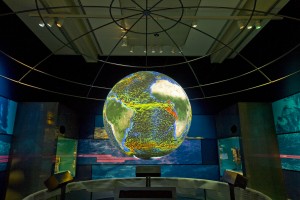Novel and revolutionary Science On a Sphere® (SOS) is an educational tool that uses computers and video projectors to help illustrate Earth System science to people of all ages.
This tool has been developed by Dr. Sandy MacDonald along with researchers at NOAA. Unique and captivating, it’s been used in science museums, visitor centers, zoos, aquariums, laboratories, and schools around the world.
It consists of a spherical projection system created by NOAA which presents high-resolution video on a suspended globe rather than a flat screen with the aim of better representing global phenomena in a way that is intuitive and captivating.
Animated images of atmospheric storms, climate change, and ocean temperature can be shown on the sphere to explain these complex environmental processes.
The sphere is attached to the ceiling or suspension structure with a three-point suspension system to hold the sphere in place and reduce lateral movement along with four strategically placed projectors.
NOAA has also recently released a free, downloadable flat screen version of its popular Science On a Sphere® (SOS), SOS ExplorerTM.
The new downloadable program allows you to view this SOS Explorer (TM) animation on a laptop and displayed on a monitor.
This new way to display the dynamics of Earth’s weather and climate and more will help teachers bring these stunning science visualizations, usually found at museums and science centers into the classroom where students can learn by using this visual tool and explore.
SOS Explorer includes a group of datasets which display animated information about the Earth’s land, oceans, and atmosphere collected by satellites, ground observations, and computer models.
Tools included in the application allow users to zoom into. This creates a great experience great for students, teachers and science lovers .
The Science On a Sphere® team and the SOS Users Collaborative Network are continually looking for ways to expand the educational capabilities as this technology can create very effective visualizations.
For more information please visit:


Comments are closed.